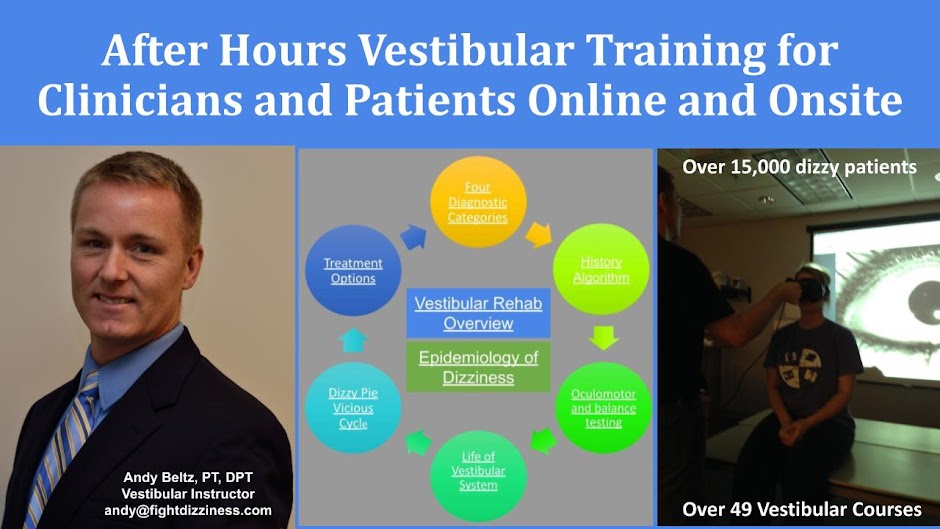what would be the most important concepts on which to focus? I believe the following would be the most important:
1. The most common causes of dizziness are from peripheral vestibular problems.
2. There are two main types of peripheral vestibular problems:
a. vestibular hypofunction
b. vestibular hyperfunction
3. The most common cause of a vestibular hypofunction is neuritis/labyrinthitis (virus).
4. The most common cause of a vestibular hyperfunction is BPPV.
5. Understanding how these problems occur will help the individual understand the type of questions to ask their clients when they say they are dizzy.
6. There are over 320 different ways people describe their dizziness, but there are some very specific questions to ask to help identify neuritis, labyrinthitis and/or BPPV.
7. There are some simple bedside tests that can be used to identify a hypofunction in room light:
a. spontaneous and gazehold nystagmus tests as well as the head impulse test
8. The Dix Hallpike and Roll tests can be utilized to identify BPPV.
9. Naming nystagmus can improve the likelihood for successful repositioning.
10. The Epley and Semont Maneuvers are often helpful if done properly and to the correct side.
11. Other maneuvers may be needed when the Otoconia are rebellious or in other canals.
12. Repositioning should be done for BPPV and Adaptation should be done for hypofunctions.
13. Sensory processing disorders may also be present with clients who are dizzy and are common.
14. Motion sensitivity, visual dependence, neck pain, headaches, imbalance, fear of falls and other forms of anxiety are common.
15. Other types of therapy and motivational education may be needed to normalize neck strength, ROM and improve nervous system homeostasis.
16. Clients should be referred to specialists when: the dizziness is acute and/or has not been diagnosed, when the practitioner lacks adequate training, when treatment has not worked or provided any relief within three to six visits, when red flags become apparent during the history or exam.
17. Beware of the trap of "It."
18 There are often several reasons for the complaints of dizziness a client is experiencing.
Monday, November 4, 2013
Sunday, November 3, 2013
Plowing your driveway in the middle of a blizzard is like trying to fix an inner ear
problem before the cause of the inner ear problem has stabilized. A person who can't stand having snow on their driveway must wait until the snow stops before plowing or shoveling their driveway to yield lasting results. Trying to fix an inner ear problem, like BPPV, before the cause of the BPPV has stabilized is similar. You can do repositioning maneuvers all day long, but if the calcium crystals are still in the process of dumping out, the repositioning attempt will likely only provide temporary relief. I have learned that treating acute BPPV is not the same as treating chronic BPPV. Sometimes, an inner ear needs time after the calcium crystals have fallen out before repositioning is effective. On the other hand, I have also noticed repositioning within hours of an individual becoming aware of their BPPV has also been effective. Different people have different types of BPPV.
Subscribe to:
Comments (Atom)
